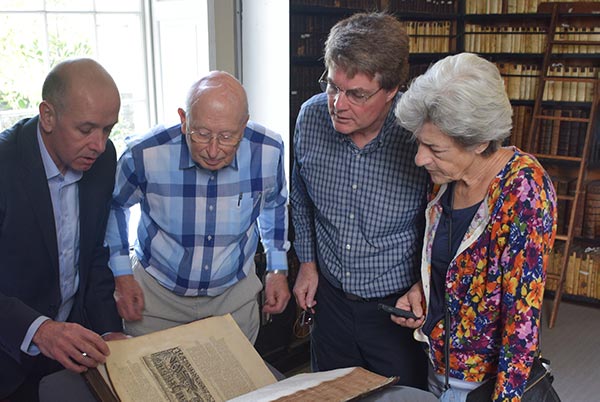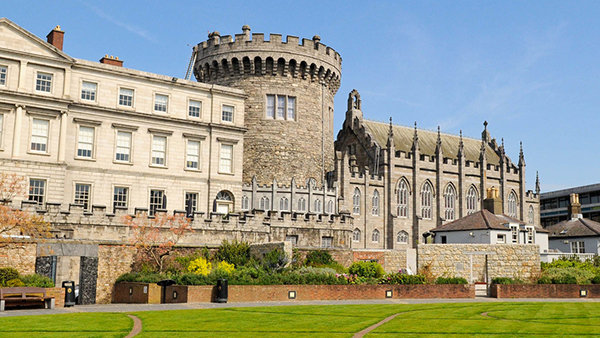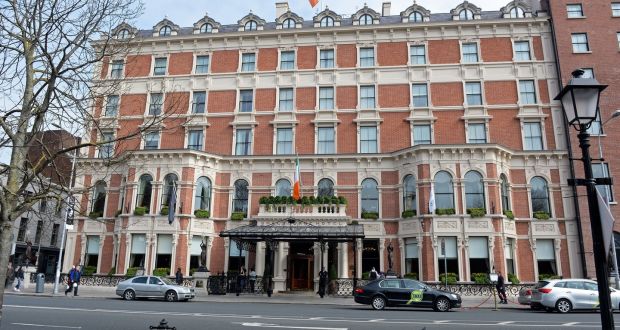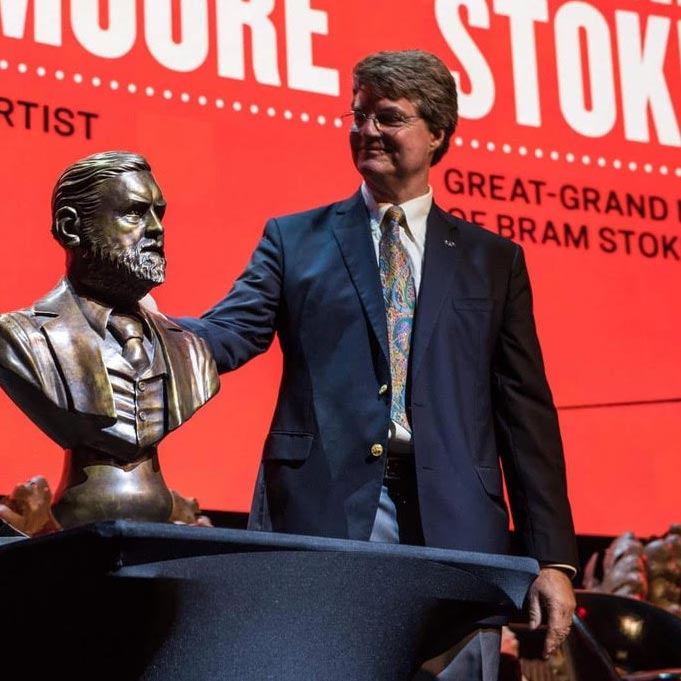Note: Not every site is visited on every tour. Tours are tailored to interests of the group, so no tour is exactly the same.
Trinity College
Trinity College, officially the College of the Holy and Undivided Trinity of Queen Elizabeth near Dublin, is the sole constituent college of the University of Dublin, a research university located in Dublin, Ireland. The college was founded in 1592 by Queen Elizabeth I as the "mother" of a new university modeled after the collegiate universities of Oxford and Cambridge, but unlike these other ancient universities, only one college was ever established; as such, the designations "Trinity College" and "University of Dublin" are usually synonymous for practical purposes.
Bram Stoker attended Trinity between 1864-1870. He was the head of the Philosophical and Historical Societies, active in Acting and Debating and won numerous athletic awards as well as the All Round Athletic Champion in 1867.
Dublin Writers Museum
The Irish literary tradition is one of the most illustrious in the world, famous for four Nobel Prize winners and for many other writers of international renown. In 1991, the Dublin Writers Museum was opened to house a history and celebration of literary Dublin. Situated in a magnificent 18th century mansion in the north city centre, the collection features the lives and works of Dublin's literary celebrities over the past three hundred years. Swift and Sheridan, Stoker, Shaw and Wilde, Yeats, Joyce and Beckett are among those presented through their books, letters, portraits and personal items. The Dublin Writers Museum is an essential visit for anyone who wants to discover, explore or simply enjoy Dublin's immense literary heritage.
Contains the bronze bust of Bram Stoker by American sculpture Bryan Moore, and the Centennial portrait of Bram Stoker by Aiden Hickey, of the Dublin Painting and Sketching Club.

Marsh’s Library
Marsh’s Library was founded in the early eighteenth century by Archbishop Narcissus Marsh (1638-1713). Designed by Sir William Robinson (d.1712) the Surveyor General of Ireland, it is one of the very few 18th century buildings left in Dublin that is still being used for its original purpose. Many of the collections in the Library are still kept on the shelves allocated to them by Marsh and by Elias Bouhéreau, the first librarian, when the Library was opened. This historic library contains records of Bram Stoker doing research here while a student at Trinity in 1866.
15 Marino Crescent
Bram’s family lived here between 1845-1849, Bram was born in the house and lived the first two and a half years here. The Bram Stoker Park is located across the street.
St John The Baptist Church 1825-1864 (ruins)
Records indicate that Bram was baptized here in 1847. There is a graveyard scene in the novel Dracul situated here.
Harry Byrnes Inn
Located on Howth Rd Clontarf, during Bram’s day this historic Inn was named Carolan’s. This gem of antiquity, which is descended from an 18th century Coaching Inn, opened its doors to the Dublin public in 1798. Now the pub remains central to the Irish way of life. Harry Byrne's has a unique history and a unique heritage. The owners take comfort in the fact that they have always been faithful to the ethos of the traditional pub despite the obvious temptations, over the years, to modernize. Co-authors D. Stoker and J.D. Barker of Dracul chose a scene in this lovely atmospheric pub.

Dublin Castle
Dublin Castle is one of the most important buildings in Irish history.
From 1204 until 1922 it was the seat of English, and later British rule in Ireland. During that time, it served principally as a residence for the British monarch’s Irish representative, the Viceroy of Ireland, and as a ceremonial and administrative centre. The Castle was originally developed as a medieval fortress under the orders of King John of England. It had four corner towers linked by high curtain walls and was built around a large central enclosure. Constructed on elevated ground once occupied by an earlier Viking settlement, the old Castle stood approximately on the site of the present Upper Castle Yard. It remained largely intact until April 1684, when a major fire caused severe damage to much of the building. Despite the extent of the fire, parts of the medieval and Viking structures survived and can still be explored by visitors today.
There is a plaque outside commemorating Bram who worked here as clerk in the Petty Sessions Judicial Department between 1866-1878. Bram’s father also worked here for 50 years, retiring in 1866.
St Stephens Green
Until 1663 St Stephen's Green was a marshy common on the edge of Dublin, used for grazing. The current landscape of the park was designed by William Sheppard. It was officially re-opened to the public on Tuesday, 27 July 1880 by Lord Ardilaun. Bram Stoker and his family members lived it the vicinity of this lovely park and would frequently wander through it.

Shelbourne Hotel
With almost two hundred years of rich history behind its genteel brick facade, The Shelbourne is a place steeped in stories. It was a Tipperary man by the name of Martin Burke who had the idea of opening a grand and fashionable hotel in one of the city's most exclusive neighborhoods. In 1824, he leased three townhouses (Number 27, 28 and 29) on the edge of St. Stephen's Green and set out to offer the best of hospitality to the most demanding guests. The idea raised some eyebrows, but Mr. Burke, with a streak of independence and a stroke of genius, pressed on.
On November 29, 1876 Bram was invited to meet Henry Irving here after writing a favorable theatrical review of the play Hamlet that Irving starred in. This meeting started in motion Bram moving to London and working with Irving for the next 27 years.
St Anns Church
The parish of St Ann was created in 1707 at a time when the eighteenth-century suburbs were beginning to envelop the site provided for the church by Sir Joshua Dawson, from whom the name of the street is derived. Together with Viscount Molesworth, he was responsible for creating some of Dublin’s most fashionable streets. Dawson Street (1709), Grafton Street (1713), Ann Street (1718), and Molesworth Street (1725). There were private pews in the church to accommodate distinguished residents like the Duke of Leinster, the Archbishop, and the Lord Mayor.
The church contains a bust of Bram Stoker, he was married to Florence Balcombe in 1878 before moving off to London to work for Henry Irving.
Castle Dracula, Clontarf
An incredible attraction for everyone to enjoy a heart-thumping experience with the characters from Dracula, while learning about Irish writer Bram Stoker, who wrote Dracula a was born nearby in Clontarf. Brave visitors journey through castle tunnels, over spinning bridges to the vampire courtyard, up to Dracula's Lair and down to the 'world’s only graveyard theatre' for a show where they promise not to bite, unless..
Swifts Hospital
The hospital was founded with money bequeathed by the political pamphleteer, Jonathan Swift, author of Gulliver’s (1726) Travels following his death as "St. Patrick's Hospital for Imbeciles". He was keen that his hospital be situated close to a general hospital because of the links between physical and mental ill-health, so St. Patrick's was built beside Dr Steevens' Hospital. The hospital, which was designed by George Semple, opened in 1747.
Co-authors D. Stoker and J.D. Barker of Dracul chose a particularly gruesome scene in the morgue in Swifts Hospital.
Hellfire Club Montpelier Hill
Needless to say, there are countless stories about what went on at the Hellfire Club, and it's likely that we'll never actually know which are truth, which are fiction, and which are a little bit of both. The lodge on Montpelier Hill remains a foreboding place to visit, the hilltop lodge is at the heart of some of Ireland's darkest stories. Stoker and Barker included a scene in Dracul at the Hellfire Club



